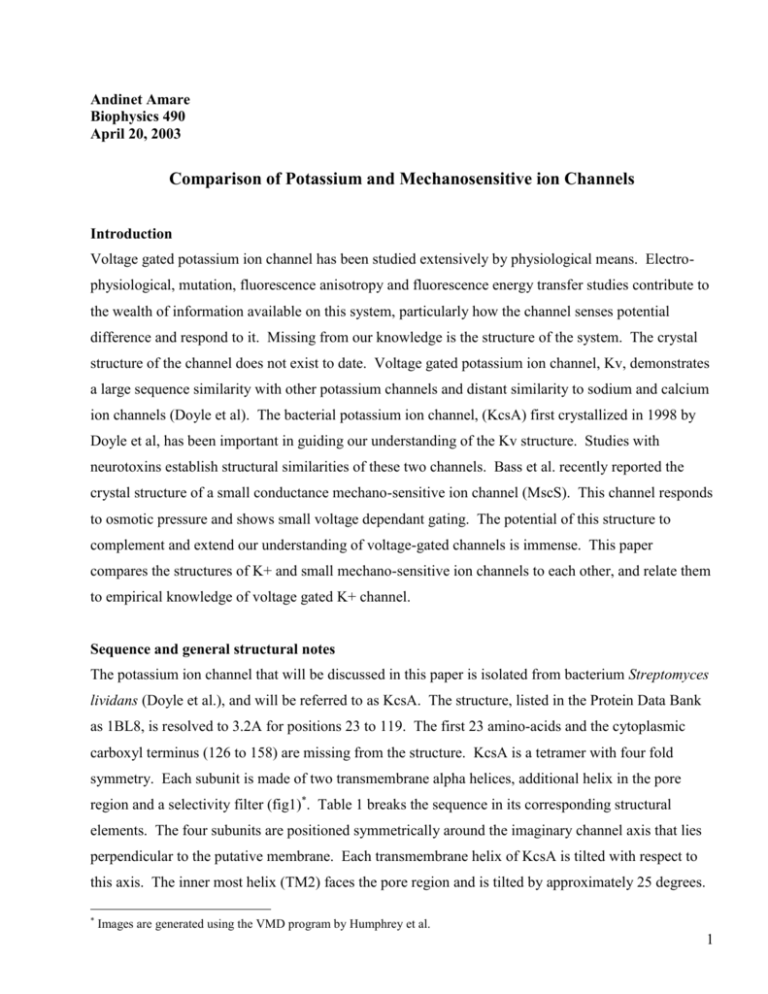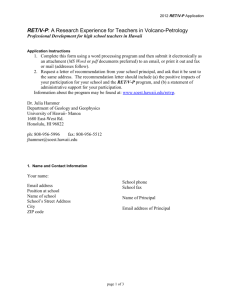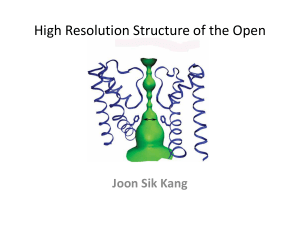Voltage gated potassium ion channel has been studied extensively
advertisement

Andinet Amare Biophysics 490 April 20, 2003 Comparison of Potassium and Mechanosensitive ion Channels Introduction Voltage gated potassium ion channel has been studied extensively by physiological means. Electrophysiological, mutation, fluorescence anisotropy and fluorescence energy transfer studies contribute to the wealth of information available on this system, particularly how the channel senses potential difference and respond to it. Missing from our knowledge is the structure of the system. The crystal structure of the channel does not exist to date. Voltage gated potassium ion channel, Kv, demonstrates a large sequence similarity with other potassium channels and distant similarity to sodium and calcium ion channels (Doyle et al). The bacterial potassium ion channel, (KcsA) first crystallized in 1998 by Doyle et al, has been important in guiding our understanding of the Kv structure. Studies with neurotoxins establish structural similarities of these two channels. Bass et al. recently reported the crystal structure of a small conductance mechano-sensitive ion channel (MscS). This channel responds to osmotic pressure and shows small voltage dependant gating. The potential of this structure to complement and extend our understanding of voltage-gated channels is immense. This paper compares the structures of K+ and small mechano-sensitive ion channels to each other, and relate them to empirical knowledge of voltage gated K+ channel. Sequence and general structural notes The potassium ion channel that will be discussed in this paper is isolated from bacterium Streptomyces lividans (Doyle et al.), and will be referred to as KcsA. The structure, listed in the Protein Data Bank as 1BL8, is resolved to 3.2A for positions 23 to 119. The first 23 amino-acids and the cytoplasmic carboxyl terminus (126 to 158) are missing from the structure. KcsA is a tetramer with four fold symmetry. Each subunit is made of two transmembrane alpha helices, additional helix in the pore region and a selectivity filter (fig1)*. Table 1 breaks the sequence in its corresponding structural elements. The four subunits are positioned symmetrically around the imaginary channel axis that lies perpendicular to the putative membrane. Each transmembrane helix of KcsA is tilted with respect to this axis. The inner most helix (TM2) faces the pore region and is tilted by approximately 25 degrees. * Images are generated using the VMD program by Humphrey et al. 1 KcsA and voltage gated K+ channels have a conserved sequence TTVGYGD (fig2). This signature sequence is reported to mark the selectivity filter and includes residues 74 to 80 on KcsA. Mutation studies on the signature amino acids resulted in loss of potassium ion selectivity (Heginbotham et al, 1992, 1994). 1a 1b 1a. Cartoon representation of two of the four subunits of KcsA channel viewed from the periplasmic into the cytoplasmic side; red: the outermost helix (TM1); gray: inner helix (TM2); yellow: selectivity filter; blue: coil; pink: pore helix. 1b. The four subunits of KcsA ion channel looking down into the ion pore from the periplasmic side. Table 1. Structural summaries of KscA (1BL8) Name TM1 loop Pore helix Selectivity filter & loop TM2 Residues 29-52 53-61 62-73 74 to 79 selectivity filter 80-84 loop 85-119 Conserved residues G30, L35, S44, E50 and A51 G88, W68, W69, T72 P83 G88, V91, A98, G99, L104 and F116 Fig. 2 shows conserved residues in K+ ion channels. 2 Pore region The ion pore region is formed by the selectivity filter and the inner helix TM2. Four TM2 helices taper down from the selectivity filter region and bunch up close to the cytoplasmic region. This pore region is predominantly hydrophobic and 10 A wide close to the middle of the membrane(Doyle). The pore region is wide enough to conduct hydrated potassium ion. The hydrophobic lining provides energetically inert surface for the hydrated ion to diffuse through. In contrast the selectivity filter is narrow and allows only dehydrated ions with radii comparable to K+. Potassium ion channels allow K+ and Rb+ ions with comparable ease and Cs+ with decreased preference while discriminating against smaller ions such as Li+ and Na+ which are practically prohibited(Doyle et al). The selectivity filter contains a high ratio of polar residues such Thr, Tyr and Asp yet these residues point away from pore towards the pore helix. Instead the oxygen from the peptide bond point inwards to the pore, and creates the highly charged environment (fig.3). In addition residues Val76 and Asp80 engage in hydrogen bonding with the pore helix while Trp68 hydrogen bonds with Thr72 of the adjacent subunit (fig 4. and table 2). Such contacts may define the pore size and prevent the pore from opening wider to allow smaller molecules with larger hydration sphere. At last, at the cytoplasmic end of the pore, a ring of oxygen is created by Glu119. This along with Glu51 and Asp80 near the selectivity filter create a suitable environment for the conduction of cations. Table 2 summarizes hydrogen bonds that exist between the selectivity filter and pore helix. (Also see figure ) Possible hydrogen bonds Distance in Angstrom Type of interaction Val 70–Thr74 Glu71-Val76 Trps68-Thr72 Trp67-Glu71 Trp67-Asp80 Trp68-Tyr78 2.78 2.99 2.93 3.24 3.53 2.60 Alpha-helical inter subunit Alpha-helical Alpha-helical Inter subunit Intra subunit 3 3a Fig 3a. shows the ion conduction pore. The inside of the selectivity filter (space filling (VDW)) is lined with main chain oxygen and is very charged. In contrast the remaining of the pore is predominantly hydrophobic (white). 3b Fig 3b. This is a closer look at the selectivity filter. Only two subunits are present and show that the main chain oxygen atoms (red) face each other. 4 Fig 4. illustrates non-helical hydrogen bonds that exist within and between subunit pore-helix and selectivity filter. 4 Small mechanosensitive ion channel The small mechanosensitive ion channel (MscS) responds to changes in osmotic pressure and small voltage. MscS is one of the two varieties of mechanosensitive channels identified thus far. MscS is characterized by small conductance and shows little sequence similarity with its functional partner MscL. This structure, with a pdb access code of 1MXM, was recently crystallized by Bass et al. MscS is a homoheptamer with transmembrane and extra-membrane parts (fig 5). The extramembraneous part is believed to protrude into the cytoplasm (Bass et al). This structure consists of mainly beta sheets and has a general spherical shape. The transmembrane section is made of three helices known as TM1 (residues 29-57) TM2 (residues 68-91) and TM3 (residues96-127). TM1 and TM2 are closely packed yet displaced from TM3 (fig 6). TM3 forms the pore region where one half of its length lies in the cytoplasmic portion of the lipid membrane and the remaining half bends significantly and lies parallel to the plane of the membrane in its intracellular side. The kink is introduced at Gly113 and the nearby residues, namely, Asp112, Ser114, Asn116 and ser117 are polar. The region surrounding this kink is and highly conserved (fig 7) and the residues lie parallel to the membrame such that the main chain oxygen point normal to the membrane. Located at the interface of the membrane and cytoplasmic domain, these oxygen atoms provide several contact points for the two domains (fig. 8). The other half of TM3 that lies in the membrane is hydrophobic consisting branched residues such as valine, leucine and isoleucine. Because the side chains are oriented radially outwards from the helix, they define the nearest contact distance with TM2 (fig 9). This is in contrast with KcsA selectivity filter which houses a few charged residues and where the main chain oxygen atoms point into the pore region. The KcsA selectivity filter is negatively charged as can be expected from its function of cation conduction. That the pore region of MscS is entirely hydrophobic is consistent with its role as a nonselective conduction channel that responds to osmotic changes. TM1, TM2 and the loop connecting them contain the largest concentration of charged and polar residues. Arg88 on TM2 extends towards the pore region providing the only charge in the pore region. The transmembrane protein is highly charged as can be illustrated by the high concentration of charged residues, namely, Arg74 on TM2, Arg54 and Arg46 on TM1, Arg59, Lys60, Asp62, and Asp67 on the loop (loop12) connecting TM1 to TM2. MscS responds not only to changes in osmolality but also to membrane depolarization (Bass et al.). The close to open transition of McsS is accompanied with an increase in cross-sectional area of 840A2 (Sukharev, S.) and the transfer of +1.7 equivalent charges completely across the membrane (Martinac, B. et al.) It is probable then loop12, TM1 and TM2 are 5 involved in the sensing of membrane depolarization. In particular, Arg46 and Arg74 are very close to each other and are located in the middle of the membrane region where they may respond to potential changes. Table 3. Structural summaries of 1MXM (MscS) Name Residues Conserved residues TM1 Loop12 TM2 29-57 58-67 68-91 Ile41, Gly45 Thr64 Tyr75, Leu86 Loop23 92-95 Gly90, Gln92, Thr93, Ser95 TM3 96-127 108-115 Gly, Leu, Ala, Leu, Gln, Gly, Ser, Leu , Gln, Ala119, Gly121, Leu123, Leu124, Val125. Fig 5. The small mechanosensitive channel of small conductance is made of seven homologous domains. The cytoplasmic domain is made mostly of beta sheets. The transmembrane region is made of three helices. cytoplasm 6 Fig 6. Transmembrane half of the mechanosensitive channel is presented looking into the channel from cytoplasmic side. The helix in pink is TM1 spanning residues 29 to 57, in white is TM2 including residues 68 to 91 and the yellow is TM2 including residues 96 to 127. Gly-113 causes a noticeable kink in TM3 and marks the beginning of the periplasmic side of the membrane. Fig b. presents a view of the mechanosensitive channel from an axis parallel to the membrane. Fig C. illustrates the kink in TM3 introduced by Gly 113. The portion of TM3 including residues 113 to 127 are oriented nearly parallel to the cytoplasimic membrane. Fig 7. Sequence comparison of MscS. Conserved residues GLALQGS (residues 108-114) surround the kink on TM3 and are polar. Sequence alignment done on Biology workbench using the CLUSTAL W algorithm. Fig 8. Looking head on into the MscS channel pore from the cytoplasmic side. The residues 108 to 115, displayed here as stick and ball are conserved sequences (GLALQGSL), and belong to the TM3 helix. TM3 bends dramatically at Gly113, and runs parallel to the membrane. In this arrangement, oxygen atoms point upwards into the cytoplasm, ready to form hydrogen bonds with the cytoplasmic domain of MscS. The distance across this pore is about 13A. 7 Figure 9a. shows TM2 and TM3 helices. Conserved redidues are displayed in green, pink ones are either Val, Leu or Ile. Fig 9b. Salt bridges between TM2 and TM3. Conserved residue Gly90 makes three bridges with Arg88, Gly87 and Gln92. Fig 10. Polar residues on the segment of TM3 that lies parallel to the membrane. Fig 10. Charged residues on TM2 and TM1. 8 Conformational changes of KcsA Shen et al studied the gating mechanism of the potassium channel in KcsA using normal mode analysis. Their study identified two pivot regions responsible for the conformational changes of the TM2 helix. One site is located about 1/3 of the TM2 region from its N terminus near the extra-cellular side. This is a rigid site characterized by minimal motion where Thr72 on the small pore helix residue contacts with residues Ala-92, Val-95 and Met-96 on TM2. The motion at this portion is described as a rocking motion of TM2 about Thr72. While the TM2 and TM1 helices are fairly mobile upon such movement, the selectivity filter and pore helix are held rigidly. This rigidity is partially conferred by ions in the channel because in the absence of ions the channel is more mobile. Fig 11. Residues Ala-92, Val-95 and Met-96 on TM2 are in contact with the small pore helix at Thr72. Thr-72 serves as a fulcrum for the rocking motion of TM2. Such rocking motion in minimal and does not perturb the selectivity filter. The second motion, responsible perhaps for the gating motion involves the lower third portion of TM2 from the N terminus involving residues Thr-107 to Leu-110. All four helices bundle at this point and undergo a concerted swinging-rotating motion. This increases the distance between TM2 helices while keeping the distance between the Thr-107 residues fairly constant. It seems then from the studies by Shen and other EPR experiment, the gating mechanism in KcsA involves the rotation of TM2 helices. Physiological and biophysical studies on the Shaker potassium channel also indicate that conformational changes associated with voltage gating. Fluorescence resonance energy transfer study on shaker ion channel suggests equivalent conformational changes mediated by tilting and rotational movement of the highly charged S4 segment upon depolarization (cha et al). Proline Proline is an alpha helix breaker and generally absent in alpha helices. There are exceptions to this rule in the membrane spanning helices (Tieleman et al). For example channel forming peptide alamethicin (Alm) has a Gly-x-x-Pro motif that forms a central kink in the helix. The D5 segment of voltage-gated chloride (CLC) channel has a conserved Gly-x-Pro sequence. Simulation studies of the 9 Kv channel in vacuum (Kerr et al.) and in lipid bilayer (Shrivastava et al.) suggest that Pro-Val-Pro (Pro-Ile-Pro) motif in the S6 helix induces a kink in the membrane which serves as a hinge for subsequent conformational change of the helix. Molecular dynamic study (Tieleman et al.) suggests a rotation around this kink. In KcsA, none of the three proline residues are found in the middle of an alpha helix. In fact proline in not present in the TM2 which is responsible for gating motion of the channel. There is one proline in the loop region between the pore helix and TM2 which potentially make hydrogen bond with Arg89. Fig 12. The three proline residues in KcsA are present the end of the helix. Two of the three prolines are shown in white. The third proline is positioned at the end of the loop that lies between the pore helix and TM2. This proline can form a hydrogen bond with Arg89 located on TM2. The thick blue loop the base of TM2 helix is the hinge associated with the concerted movement of TM2 responsible for the gating mechanism. Gating motion and proline presence in MscS The x-ray diffraction density of MscS helices suggest that they are more conformationally mobile than the rest of the protein(Bass et al). The channel pore, mostly defined by TM3 from residue 96 to 113, is relatively rigid much like KcsA pore region. TM3 is anchored at both ends. From the cytoplamic end, half of the helix forms hydrogen bonds with the cytoplasmic domain (see fig. 8). From the periplasmic end, the loop connecting TM2 and TM3 is characterized with several salt bridges (fig 9b), perhaps limiting the mobility of TM3. The tilt of TM3 is similar to the pore helix of KcsA. However, there is a pronounced kink at Gly113 after which the helix becomes nearly parallel to the helix axis defined as perpendicular to the putative membrane. Like KcsA the pore region is relatively rigid. Unlike KcsA, MscS does not contain any proline residue in its transmembrane domain. Summary Major structural differences in KcsA and MscS lie in the pore region. KcsA has a charged selectivity filter with is used to select K+ and other ions of similar radii. Also this selectivity filter makes many contacts with the pore helix thus constraining the mobility of the pore region. Apart from the selectivity filter and surrounding area, the rest of KcsA is non-polar. MscS, on the other hand, is non10 polar in the pore region, and charged elsewhere with few basic residues that are responsible for voltage sensing. There is a conserved region at the pore region, near the cytoplasm that bends dramatically and forms hydrogen bonds with the cytoplasmic domain of MscS. In both structures the inner most helices are relatively immobile compared to the other helices. Reference: Bass, R., Strop, P., Barclay, M. and Rees, Douglas. Crystal structure of Escherichia coli MscS, a voltage-modulated and mechanosensitive channel.(2002) Science 298:1582-1587. Bezanilla, F. (2000) Voltage sensing in voltage dependent ion channels. Physiol. Rev. 80:555-592. Cha, A., Snyder, G, Selvin, P and Bezanilla, F. (1999) Atomic scale movement of the voltage-sensing region in a potassium channel measured via spectroscopy. Nature 402:813-817. Heginbotham, L., Abramson, T. and McKinnon, R. (1992) Science 258, 1152. Heginbotham, L., Lu, Z., Abramson, T. and McKinnon, R. (1994) J. Biophys. 66, 1061. Humphrey, W., Dalke, A. and Schulten, K. (1996) "VMD - Visual Molecular Dynamics", J. Molec. Graphics, 14, pp. 33-38. Kerr, I., Son, H., Sankararamakrishnan, R., Sansom, M. (1996) Molecular dynamics simulations of isolated tarnsmembtrane helices of potassium channels. Biopolymers 30:503-515. MacKinnon R. (1991) Determination of the subunit stoichiometry of voltage-activated potassium channel. Nature 350, 232-235. Martinac, B., Beuchner, M., Delcour, A., Adler, J., and Kung, C. (1987). Proc. Natl. Acad. Sci. U.S.A. 84, 2297. Shen, Y, Kong, Y. and Ma, J. (2002) Intrinsic flexibility and gating mechanism of the potassium channel KcsA. PNAS 99, 1949-1953. Shrivastava, I., Capener, F, Roffest L, Sanson, M. (2000) Structure and dynamics of K+ channel prole-lining helices: a comparative simulation study. Biophys. J.; 78:79-92. Starace, D, Stefani, E., and Bezanilla, F. (1997) Voltage-Dependant Proton Transport by the voltage sensor of the Shaker K+ Channel. Neuron, 19, 1319-1327. Sukharev, S. Biophys. J. (2002) 83, 290. Tieleman, D.P., Shrivastava, I., Ulmschneider M., and Sansom, M. Proline-induced hinges in transmembrane helices: possible role in ion channel gating. (2001) Protein struc. Func. Genet. 44:6372. 11








